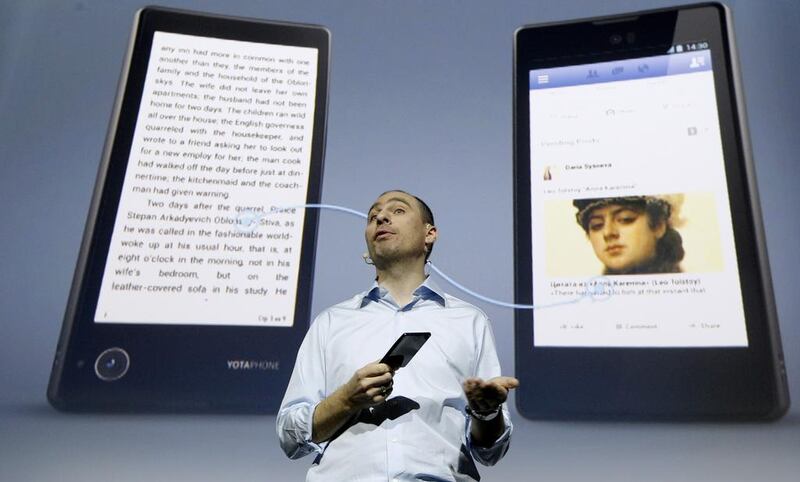The Russian company behind an innovative dual-screen handset offering longer battery life is looking to shake up the smartphone market and win share from segment leaders Samsung and Apple.
At first glance, the YotaPhone – which is now available in the UAE – looks like any other Android phone, but flip the device over and there is an e-reader on the back.
Users can choose what to display on the back screen, be it a newsfeed, social media updates, a map, a favourite picture or a boarding pass. The back screen is always on, even if the battery dies.
“Now you don’t need to be afraid you will kill your battery because you are reading on your smartphone,” said Vladislav Martynov, the chief executive of Yota Devices. “It is an electronic paper display so it is much easier on your eyes and there is no reflection.”
Some 40 to 50 per cent of a smartphone’s battery is used up by the screen, which is why very few smartphones can make it through a whole day on a single charge. The YotaPhone’s back screen provides up to 50 hours of reading if the front screen is not put to use. The company claims it provides seven to eight hours of more battery life than the standard smartphone.
“We strongly believe the future of smartphones is always-on display and dual screen phones,” said Mr Martynov, whose device has won a string of awards, including the International Consumer Electronic’s “hottest mobile device” and a gold Cannes Lion.
“Being a small start-up from Russia, to have enough courage to take on the big manufacturers, when we see all this recognition, it helps us develop our business,” added Mr Martynov.
Yota has partnered with Jumbo Electronics, which will sell the device for Dh2,199. Jumbo and Yota are aiming for sales of 10,000 for the YotaPhone as tech enthusiasts and artsy people who want to stand out are most likely to invest in the device.
A TRA report showed that the iPhone 5 was the most popular smartphone in the country in the third quarter of last year, with a 2.8 per cent share of all registered handsets. Coming second was the Samsung S3 with 2.5 per cent. The iPhone 4S was third with 2.3 per cent, and tied for fourth were the iPhone4 and BlackBerry 9900 at 1.8 per cent.
“This is not a mass market device today, but eventually all phones will be made this way,” said Vishesh Bhatia, the chief executive at Jumbo.
The second generation YotaPhone, set for release in six months will be positioned for the mass market, said Mr Martynov.
“The Yotaphone is interesting in that it focuses on core functionality issues of a smartphone by intelligently using the second screen at a time when most other manufacturers have diverted their focus on aspects of durability or health apps,” said Ashish Panjabi, chief operating officer at Jacky’s Electronics. “Yotaphone’s focus on battery life using the e-ink screen is also refreshing but the phone feels a bit bulky in the hand.”
thamid@thenational.ae
Follow us on Twitter @Ind_Insights





